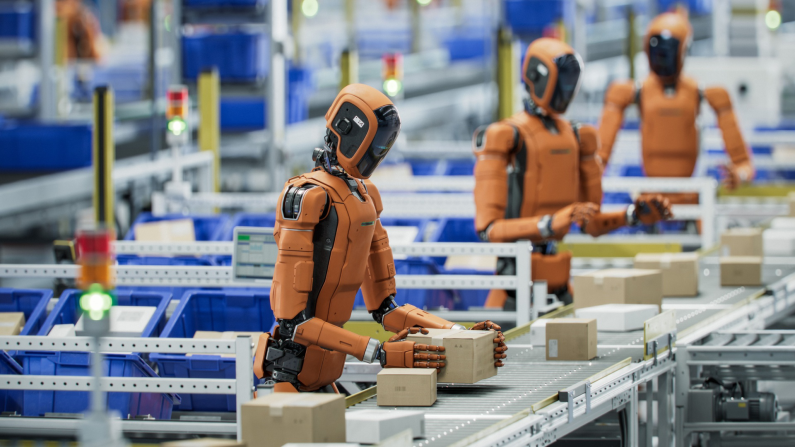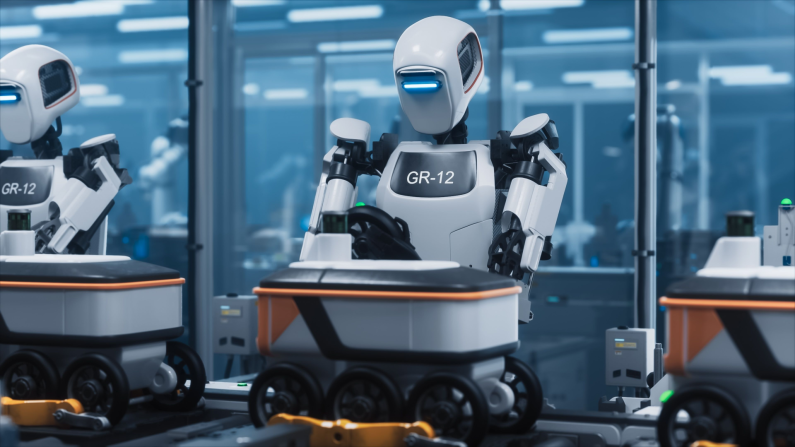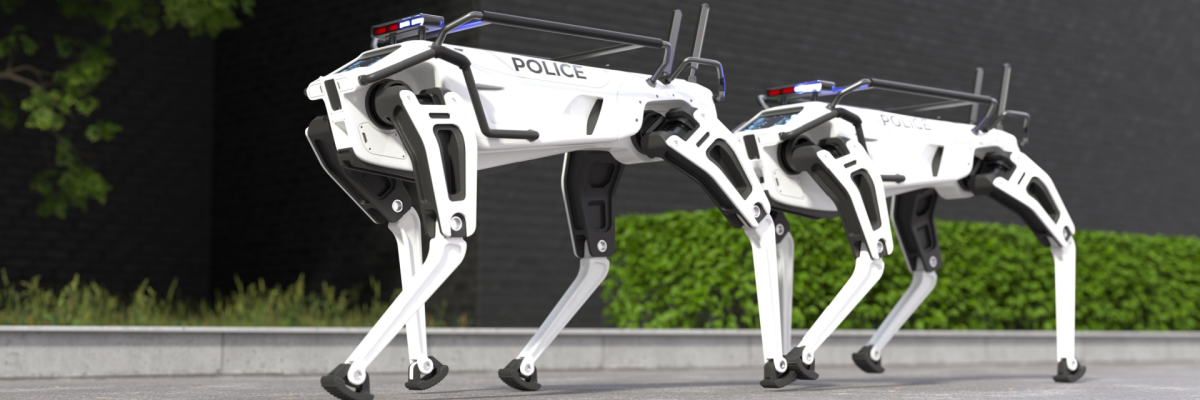In recent years, we have been witnessing a large-scale technological revolution. Innovations are emerging at the speed of light — moreover, the very model of interaction between humans and machines is changing. It seems that not long ago, robots were associated solely with science fiction, but today they are deeply integrated into the everyday lives of both tech enthusiasts and ordinary people.
The purpose of robots has also evolved. Whereas automation once referred only to routine tasks, robots are now becoming full-fledged partners — adapting, learning, and acting alongside humans. In this article, we will explore how robotics is developing and how machines are transforming industry, logistics, and services.
From Service to Industrial Solutions

Robotics is experiencing a new wave of growth and transformation. The global robotics systems market in 2025 is projected to reach approximately $50 billion, representing growth of about 11% compared to the previous year.
Key drivers of this market include mobile robots, automated delivery systems, and integration with AI and digital twins. Here are several trends worth noting:
-
AI and autonomy integration: robots are shifting from rigidly programmed systems to adaptive ones capable of responding to changes in their environment.
-
Digital twins: simulation models that enable optimization of robot operations and interaction with the physical world.
-
Service and mobile platforms: autonomous mobile robots (AMRs), logistics “agents,” and assistant robots are coming to the forefront.
-
Humanoid formats and exoskeletons: though still a niche segment, demand is growing for robots that resemble humans in both appearance and function, or that enhance human physical abilities.
-
Sustainability and ecology: robot production and operation are increasingly focused on energy efficiency and minimizing environmental impact.
How Robots Are Transforming Industry, Logistics, and Services

When robots are deployed widely, it’s not just about automating individual tasks — it’s about transforming entire systems: structures, processes, and roles.
- Industry
Robots have long been common in manufacturing, but their role is deepening — from repetitive tasks to complex, flexible operations. Working with adaptive robots, interacting with AI systems, and quickly reconfiguring production lines have become part of modern factories. Experts note the growing popularity of the “Human + Robot” concept, where robots do not replace but complement people — taking on heavy or hazardous tasks while leaving control and decision-making to humans.
- Logistics
Autonomous mobile robots are now widely used in warehouses — for moving goods, assembling orders, and performing internal deliveries. This increases speed, precision, and quality while reducing costs.
- Services and Everyday Applications
Assistant robots are becoming increasingly popular in service sectors — from cleaning and home automation to elder care. Services once purely human are becoming automated or hybrid. This not only optimizes costs but opens up new possibilities.
The Latest Innovations in Robotics

- Humanoid Robots
The humanoid format remains rare but is becoming more realistic and applicable. Perhaps the most famous example is Sophia, developed by Hanson Robotics (Hong Kong / USA). Sophia even received citizenship from Saudi Arabia. Another creation by the same company is Albert HUBO, featuring the head of Albert Einstein.
These robots are designed for human interaction: facial and emotion recognition, conversation, and expression of feelings. Hanson Robotics’ proprietary Frubber technology mimics human skin and facial expressions. The company focuses more on showcasing humanoid and social applications than on mass industrial production.
Another U.S.-based company, Agility Robotics, created Digit, a humanoid robot about 175 cm tall and weighing 65 kg. Unlike Sophia, Digit is designed for physical tasks, particularly in logistics — carrying loads, working in warehouses, and autonomously navigating stairs.
Spain’s PAL Robotics also specializes in humanoid robots; one of its models, ARI, was developed specifically as a social companion robot.
- Mobile and Logistics Robots
In logistics and warehousing, autonomous mobile robots and robotic manipulators have become the standard. They can move, navigate spaces, and work alongside humans. Experts note that the mobile robotics segment is expected to grow faster than traditional industrial robotics.
For example, Boston Dynamics developed Stretch — a mobile robot with a powerful vacuum “arm” and lidar camera, designed to move boxes in warehouses and freight terminals. It can handle up to 800 boxes per hour and optimize its route autonomously.
Another notable company is Locus Robotics, one of the most successful developers of robotic logistics systems for online retail. Its robots navigate warehouse routes, work side by side with human staff, and can boost productivity two- to threefold.
Meanwhile, China’s Geek+ is often called the global leader in logistics robotics, with over 30,000 active robots worldwide. Its lineup includes P-Series (lifting AMRs), S-Series (sorters), and RoboShuttle systems, which transport product containers to warehouse operators for order fulfillment and adjust their height for convenient access.
- Service Robots and Household Assistants
Robotic assistants, eldercare robots, and domestic helpers are another fast-growing segment. Studies show that the service robotics market will become one of the key branches of robotics by 2025.
For instance, Hanson Robotics also created Grace, a nurse robot introduced in 2021. Grace specializes in elderly and patient care and is equipped with medical sensors for measuring temperature, pulse, and respiration.
Another example is Enabot EBO Air 2 — a compact mobile companion robot with a 2K camera and home navigation system. It provides visual monitoring, two-way communication, and environmental awareness.
Other promising models include:
-
PECOLA — a Taiwanese companion robot for seniors, featuring diet, sleep, and fall monitoring, plus video calls.
-
Zenbo by ASUS — a home assistant robot with features such as medication reminders, elderly monitoring, and emergency alerts.
-
Paro — a therapeutic seal-shaped robot pet for emotional support of elderly individuals and those with dementia.
-
Lio — a mobile assistant platform for care facilities, equipped with sensors, navigation, and autonomous operation.
- Exoskeletons
Complementary systems that enhance human physical capabilities — exoskeletons and assistive robots — are also in high demand.
For example, Sarcos Robotics developed the Guardian XO, primarily for industrial use — to help workers lift heavy loads, reducing injury and fatigue. It can assist with weights from about 35 to 200 pounds (≈16–90 kg) and operates up to 8 hours per charge.
Ekso Bionics designs medical and industrial exoskeletons. Their models include EksoNR, a rehabilitation suit for stroke and spinal cord injury patients; Indego, a lightweight modular personal exoskeleton for users with mobility impairments; and EVO, an industrial version that enhances work efficiency.
Japan’s Cyberdyne Inc. created HAL — a robotic exoskeleton focused on movement assistance, rehabilitation, and elder support. It reads bioelectric signals from the user’s muscles and nerves to assist movement.
Modern exoskeletons are becoming increasingly user-friendly, autonomous, and adaptive, featuring battery-powered mobility and sensor-based control.
Human–Machine Collaboration: Co-bots and Social Robots

One of the most fascinating trends is not human replacement, but collaboration. So-called “cobots” (collaborative robots) and social robots serve as bridges between humans and machines.
- Cobots
Collaborative robots are designed to work safely alongside humans — sharing workspace, tasks, and assistance. Unlike traditional industrial robots, which operate in isolated zones, cobots embody the human-centered automation approach popular in Europe.
They are already used in tasks such as assembly assistance, inspection, and packaging — areas that require flexibility and direct interaction with people.
- Social Robots
This category focuses on human interaction — not just as tools, but as companions, interfaces, and the “faces” of automation. Examples include caregiving robots, guides, and conversational assistants for seniors. Their purpose is not merely task execution but contextual understanding, emotional response, and interactive communication.
The human–robot interaction trend includes elements like machine emotional intelligence, behavioral adaptability, and the ability to learn from and with humans. This synergy is one of the key growth areas for robotics in 2025.
- Rethinking Workspaces
When humans and machines work side by side, not only technology but the very structure of labor changes. Production lines become flexible, roles evolve, and new skills emerge — observing, guiding, and effectively collaborating with machines. This is more than automation; it is symbiosis.
- Educational and Social Impact
Interacting with robots requires not only technical but also social skills — the ability to treat machines as colleagues, understand their limitations, and build mutual trust and control. This is a new form of competence already in demand across industries.
The Ethics of Human–Robot Interaction: Trust, Emotion, and Responsibility

As robots become part of daily life, ethical questions come to the forefront. These are not just technical issues — they are social, cultural, and legal.
Research shows that for people to embrace robotics, it must be understandable, safe, and demonstrably beneficial. Many developers cite improved quality of life as the key factor for public trust. A lack of trust leads to resistance, fear, and anxiety — over job loss, loss of control, or machine error.
It is becoming increasingly clear that robots — especially autonomous and social ones — require ethical frameworks. The “robot ethics” market is valued at $3.22 billion in 2025 and is projected to reach $7.77 billion by 2032. Key focus areas include data privacy, algorithmic fairness, interaction safety, and explainability of machine decisions. These are particularly critical in healthcare, caregiving, and service contexts.
The European approach to robotics emphasizes that robots should augment and extend human abilities, not replace them entirely. Therefore, safety and user comfort are top priorities. According to multiple studies, about 60% of developers see job displacement risk and lack of transparency as the main ethical challenges.
Moreover, the spread of robotics may deepen social inequality: countries and companies without access to advanced technologies may fall behind, and workers may lose opportunities.
A world populated by robots alongside humans is no longer beyond the horizon. In 2025, robotics is undergoing not just quantitative growth but a qualitative shift — from repetitive tasks to adaptive systems, from tools to partners, from assembly lines to flexible spaces of human–machine collaboration.
Yet it is crucial to remember: machines will not replace people. Their true strength lies in partnership and cooperation with us. While robots take on dangerous, time-consuming, or routine tasks, humans will continue to lead with creativity, decision-making, and social intelligence.
Share this with your friends!






Be the first to comment
Please log in to comment